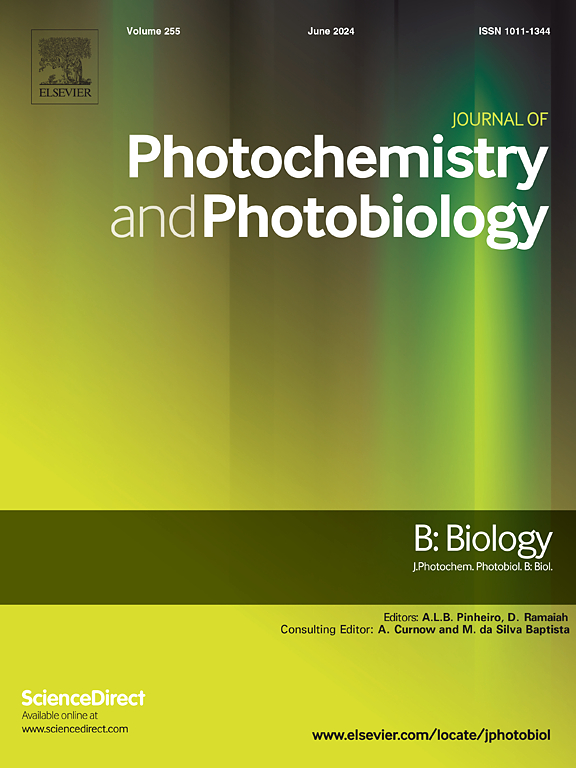Aggregated gold nanoparticles as photoactivators for the photopolymerization of proteins
IF 3.9
2区 生物学
Q2 BIOCHEMISTRY & MOLECULAR BIOLOGY
Journal of photochemistry and photobiology. B, Biology
Pub Date : 2025-02-01
DOI:10.1016/j.jphotobiol.2025.113099
引用次数: 0
Abstract
Photopolymerization of bovine serum albumin was carried out using reactive oxygen species (ROS) generated by the irradiation of citrate-stabilized gold nanoparticles by a pulsed Nd3+:YAG laser. The ROS in this case, singlet oxygen (1O2), targets aromatic amino acids within the protein to induce photopolymerization or crosslinking. Other ROS, like the hydroxyl radical, can also form in solution and under high-energy irradiation. The gold nanoparticles were aggregated using different cations in order to maximize singlet oxygen production. Experimental parameters like exposure time and laser power were optimized to minimize damage and maximize crosslinking efficiency, and damage-free crosslinking was observed at laser exposures up to 60 s with samples containing calcium demonstrating most efficient crosslinking. To confirm the role of ROS in crosslinking, the reactive oxygen scavengers sodium azide and mannitol were added at different concentrations to scavenge the singlet oxygen and hydroxyl radical, respectively, and both were observed to stop or slow the formation of crosslinking. The use of gold nanoparticles offers an inert and biocompatible alternative to organic crosslinking agents like rose Bengal and methylene blue.

聚集的金纳米颗粒作为光活化剂用于蛋白质的光聚合。
利用脉冲Nd3+:YAG激光照射柠檬酸盐稳定金纳米粒子产生的活性氧(ROS)进行了牛血清白蛋白的光聚合。在这种情况下,ROS,单线态氧(1O2),以蛋白质内的芳香氨基酸为目标,诱导光聚合或交联。其他ROS,如羟基自由基,也可以在溶液和高能照射下形成。为了最大限度地产生单线态氧,用不同的阳离子聚集了金纳米颗粒。实验参数如曝光时间和激光功率优化,以最大限度地减少损伤和最大限度地提高交联效率,并观察到无损伤交联在激光照射60 s,样品中含有钙显示最有效的交联。为了证实ROS在交联中的作用,我们分别添加了不同浓度的活性氧清除剂叠氮化钠和甘露醇来清除单线态氧和羟基自由基,观察到两者都能阻止或减缓交联的形成。金纳米颗粒的使用提供了一种惰性和生物相容性的替代有机交联剂,如孟加拉玫瑰和亚甲基蓝。
本文章由计算机程序翻译,如有差异,请以英文原文为准。
求助全文
约1分钟内获得全文
求助全文
来源期刊
CiteScore
12.10
自引率
1.90%
发文量
161
审稿时长
37 days
期刊介绍:
The Journal of Photochemistry and Photobiology B: Biology provides a forum for the publication of papers relating to the various aspects of photobiology, as well as a means for communication in this multidisciplinary field.
The scope includes:
- Bioluminescence
- Chronobiology
- DNA repair
- Environmental photobiology
- Nanotechnology in photobiology
- Photocarcinogenesis
- Photochemistry of biomolecules
- Photodynamic therapy
- Photomedicine
- Photomorphogenesis
- Photomovement
- Photoreception
- Photosensitization
- Photosynthesis
- Phototechnology
- Spectroscopy of biological systems
- UV and visible radiation effects and vision.

 求助内容:
求助内容: 应助结果提醒方式:
应助结果提醒方式:


